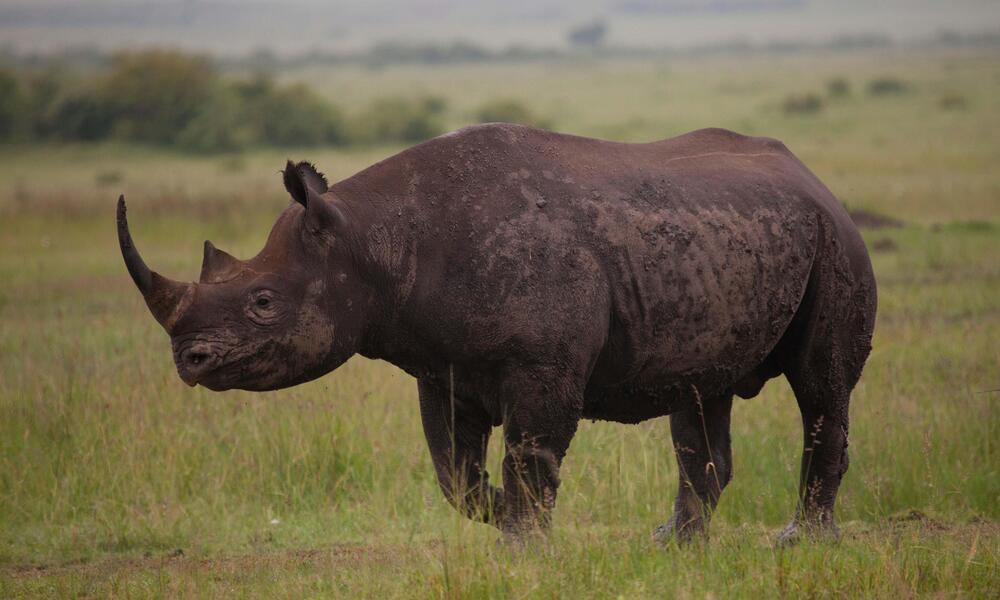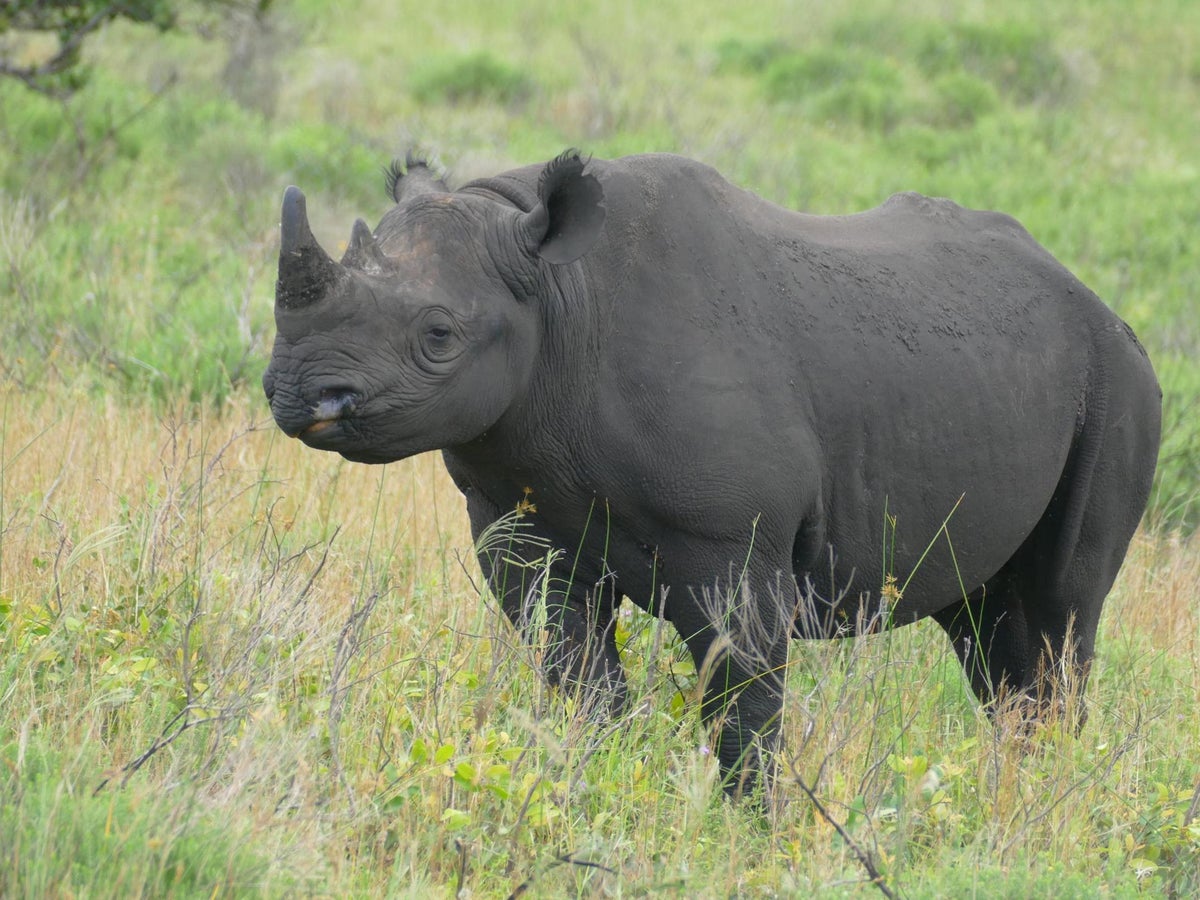South Western Black Rhinoceros: Rhino Extinct
Diceros bicornis occidentalis, often known as the south-western black rhinoceros, is a subspecies of the black rhinoceros that may be found in southwestern Africa (northern Namibia and southern Angola, introduced to South Africa).
The International Union for Conservation of Nature (IUCN) has classified it as Near Threatened. Illegal poaching is the most serious danger to the subspecies’ survival.

Physical description
Although the black rhino is smaller than the white rhino, adults may still grow to be 1.5 meters tall and weigh 1.4 tonnes, despite their smaller size.
When compared to the white rhino, the hook-lipped rhino is distinguishable by the presence of a prehensile top lip (hence the alternative name of hook-lipped rhino), which it utilizes to graze on the twigs of woody plants and a variety of herbaceous plants. Acacias are among the plants that they like the most.
The front horn is the longest of the two horns, measuring around 50cm in length on average.

Taxonomy
The South Western black rhinoceros was first described by Scottish zoologist Andrew Smith in 1827. It is one of three subspecies of the black rhinoceros (Diceros bicornis), and is also known as the Cape, or Namibian, black rhinoceros. The other two subspecies are the Eastern black rhinoceros (D.b. michaeli) and the Southern black rhinoceros (D.b. minor).
The South Western black rhinoceros is a member of the family Rhinocerotidae, which includes all species of rhino. It is one of five extant rhinoceros species, and is one of two African rhinoceros species, the other being the white rhinoceros (Ceratotherium simum).
The South Western black rhinoceros is distinguished from the other subspecies by its smaller size, squarer lip, and less prominent horn.
Population and potential risks
The South Western black rhinoceros is the most endangered of the three subspecies, with an estimated wild population of only 5,055 individuals in 2008. The majority of the population is found in Namibia (4,180 individuals), with smaller populations in Zimbabwe (825 individuals) and South Africa (50 individuals).
The species is classified as Critically Endangered by the IUCN Red List, and is threatened by habitat loss, poaching, and human-wildlife conflict.

Life cycle
Adult south western black rhinoceros are generally solitary animals throughout their adulthood. It is possible for a mother and daughters to remain together for extended periods of time, but a female without kids may associate with another female in the vicinity.
Females attain sexual maturity at the age of 4-5 years, however it is not until the age of 6.5-7 years that they give birth to their first calf. Males must wait until they are 10-12 years old before they may claim a territory and begin courting a female partner. Black rhinos may live for 40 to 50 years in the wild.
Conflicts over a female might result in the death of one of the competing males during the wooing process.
Every month of the year is a breeding season. The gestation time ranges between 419 and 478 days, with an average gap between calves of 2.5-3.5 years between each birth. Black rhino calves begin to wean when they are around 2 months old.
Geographical location and natural environment
African countries with black rhinos include Kenya, Tanzania, Namibia, South Africa, and Zimbabwe. They may be found across southern and eastern Africa.
Its habitat varies depending on whether or not there are adequate resources to maintain the rhino population. When searching for a new home, rhinos will seek for a location where there is a plentiful quantity of bushes and woody herb and plant life, as well as a location where there is a nearby water source and mineral licks, all of which are within a 5-10 mile radius. A broad variety of ecosystems in Africa are affected by this, including semi-desert savannah, woods, forests, and wetlands, among others.
Within a given region, the population density is as follows: This varies depending on the characteristics of the area in issue, ranging from one rhino per 100 km2 on the dry plains of Western Kunene, Namibia, to more than one rhino per square kilometer in thicket vegetation in the Congo Basin.

The relationship between social behavior and territory
Sociability: Depending on the environment, black rhinos may be either solitary and territorial, or semi-social and less fiercely territorial, depending on the situation. It was captured on incredible film from the current BBC Africa series showing a herd of black rhinos congregated socially at a waterhole, dispelling the popular belief that these animals are exclusively solitary creatures.
Male territory: A normal bull’s territorial range is around 3.9-4.7 kilometers in length. Adult male black rhinos prefer to live on their own, with the exception of when they are wooing a female partner. There are two types of animals among males: dominant and submissive. Subordinate rhino within these regions are often young adults who must submit to the dominant bull in order to survive. A lot of young bulls and elderly males that are unable to defend themselves as effectively are killed or damaged in violent territorial confrontations. They may also get trapped in one tiny territory until they die.
Female domain typically stretches between 5.8 and 7.7 kilometers in length. Females prefer to be solitary, and they are generally only seen in the company of their most recent calf (if they have one).
Scent-marking is a particularly important mode of communication for rhinos, which have relatively poor vision and typically live in isolation. Females use urine spraying as a method of signaling to neighboring bulls when they are in oestrus, which is a frequent method of scent-marking for both males attempting to mark their territory and females signaling to adjacent bulls when they are in oestrus.
Spraying spurts may have a range of up to 3-4 metres and can be seen along feeding and watering paths, among other places. Dung heaps, often known as’middens,’ are a typical scent-mark left by animals. Black rhinos may defecate in the same area again and over again, or they may scatter dung heaps over their home range.
Rubbing one’s head against a rock or tree is another method of scent marking: black rhinos rub a smell gland placed on their skin against a rock or tree to mark a territory, leaving a unique aroma behind.
Rhinos make a variety of sounds, the most prevalent of which are sniffing and snorting, particularly when they are agitated. The use of grunting as a method of communication across social groups has also been reported in certain instances.
A black rhino’s daily activity varies according on the time of day. They are most active during the daytime hours of 10 a.m. to 3 p.m., when they seek shade behind huge boulders, trees, or mud wallows. They are the least active at night.
Other interesting facts
Food: Black rhinos are browsers (i.e., they consume trees, bushes, and shrubs), as opposed to their white rhino counterparts, which are grazers (eat grasses and other plants). When they bite off woody plant parts, the design of their hooked lip allows them to leave a clean-angled (pruning-shear type) edge (elephants like to shred the ends of branches like a toothbrush). This is made possible by the structure of their hooked lip. The traces in their excrement show that they have eaten this woody stuff in a nicely chewed manner.
The black rhino has weak vision, similar to that of white rhinos, and is unable to identify an observer standing more than 30 yards away, much as white rhinos do. These creatures do, however, have outstanding senses of smell and sound.
Footprint: Like other rhino species, they have three toes, and hence three strong nails, which create imprints on the ground to the front and side of a softer wrinkled sole, which leaves impressions on the ground to the front and side of the softer wrinkled sole. The front feet of these creatures are larger than the rear feet.
Running speed: Black rhinos can run at speeds of up to 55 kilometers per hour and have been documented doing so. They are able to shift direction astonishingly swiftly and can sprint through brush and thorns with little difficulty.
Black rhinos may live up to 30-35 years in the wild and 35-45 years in captivity, depending on the species.
Relationships of friendship: red and yellow-
When encountered with rhinos, billed ox-peckers provide them with a valuable service by removing ticks and parasites from any open wounds, and also by sounding the alarm if there is any danger coming.
In terms of gender ratios, more male calves are born than female calves, but the death rate for male calves is greater, resulting in male-to-female sex ratios in adults that are skewed towards females.
:max_bytes(150000):strip_icc()/__opt__aboutcom__coeus__resources__content_migration__mnn__images__2017__02__black-rhino-ba3eb16445494eb0a9f0d995c5d7cffa.jpg)
The situation is in jeopardy
Background: During the nineteenth century, as European influence over land use and trade increased, the black rhinoceros, which was the most numerous rhino species with several hundred thousand animals, was relentlessly hunted across most of Africa, resulting in the extinction of the species. By 1970, it was believed that just 65,000 animals remained.
As a consequence of a rise in poaching Chinese medicine, the black rhino has become more uncommon in recent years. Poaching pressure increased throughout the 1970s and 1980s as a result of an increase in the demand for rhino horn in Asia and the Middle East. A 96 percent decline in the number of black rhinos occurred between 1970 and 1992, with overall numbers plunging as low as 2,400 individuals at one point.
Poachers continue to pose the greatest danger to the black rhinoceros in the present. However, with rigorous protection and careful biological management, black rhino populations are progressively rebounding, and there are presently between 5,040 and 5,458 individuals left in the wild, according to estimates (according to figures published by IUCN in 2016).
F.A.Q talk about South Western Black Rhinoceros:
How many southern black rhinoceros remain in the wild?
Today, the black rhino population is estimated to be at 5,600 individuals. Rhinos are poached for their horns, which are believed to be used for unproven medical or ornamental reasons.
Is there a chance that any western black rhinos will survive?
Black Rhino populations in South Africa and Zimbabwe are the most numerous, with a minor population located in southern Tanzania, according to the International Union of Conservation.
A subspecies of the Black Rhino known as the Western subspecies was last seen in Cameroon, and it is now presumed extinct.
Where do southern black rhinoceros make their residence?
The southern-central black rhinoceros (D. b. minor) is the most abundant of the rhinoceros subspecies. Found in South Africa, Zimbabwe, southern Tanzania, and has been reintroduced to Botswana, Malawi, Swaziland, and Zambia after being extinct for some years.
Conclusion:
And this article Westernencounters.com will help you answer questions about South Western Black Rhinoceros:
- The black rhinoceros (Diceros bicornis) is a massive
- Western black rhino
- the black rhino lives in africa. it’s one of largest land animals
- Black Rhino
- Rhino extinct
- White rhino
- Black rhinos are the smaller of the two African rhino



























